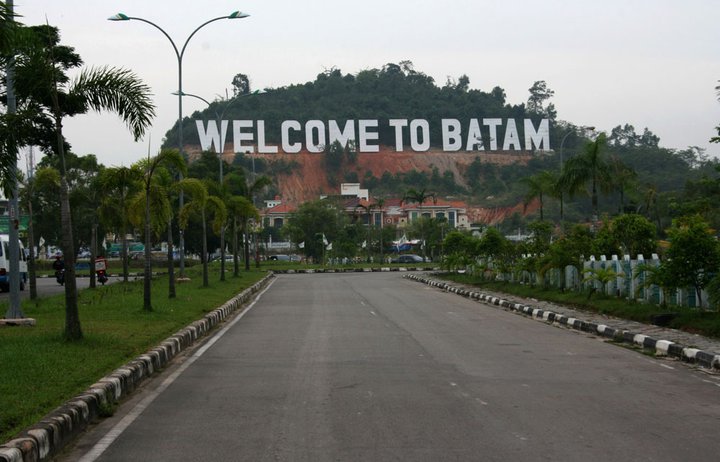Batam is one of the 3,000 islands, which make up the Riau Archipelago and is closest to Singapore, which is only 20 km away or twenty minutes by air-conditioned ferry. It has a rapid-growing population of around 100.000. As the island develops into a major industrial and tourist area, it attracts an ever-increasing population from other Indonesian islands who see Batam as a haven of opportunity. Once almost uninhabited, save for a few scattered fishing communities, Batam's history took a sharp turn beginning 1969, when it became support base for the State-owned 'Pertamina oil company' and its offshore oil exploration. In 1971 a presidential decree designated it as an industrial area and in 1975 the Batam Authority was formed. In 1978 Batam was established as a bonded area.
In addition to the oil support industries of Batu Ampar and a fast growing electronics industry, Batam now attracts increasing numbers of tourists. Many come from Singapore for a short holiday with friends and family, duty-free shopping and great seafood. The visitors to Singapore hope over for a day or weekend trip.
International standard hotels and numerous economy establishments cater to the expanding demand for accommodation. Business, as they say, is booming. An island two-thirds the size of Singapore, Batam progresses by leaps and bounds. Where virgin jungle once stood are now whole new towns, mosques, churches, temples and supermarkets, soon to be followed by reservoirs with enough water to supply a population of 800,000 and for industrial use, an airport-to become an international gateway - a fine telecommunication system, well equipped industrial parks, and the beginnings of a large new urban center.
Administratively, Batam enjoys a unique status under the Batam Island Development Authority (BIDA). The island is duty-free. The holiday market, this means duty free shopping in town, hotel shops and the ferry terminal. For the businessmen it means wide-ranging opportunities for investments. While all this change takes place, Batam has retained pockets of rural charm, peaceful spots with quiet beaches. Fishing villages supply delicious fresh seafood to visitors. White sand beaches are fringed with palms and kampung life carries on almost undisturbed. Batam makes a great break.
One of Batam's biggest attractions is the fresh and delicious seafood. Giant prawns, live still crawling crabs, live fish taken straight from nets in the sea, lobsters, clams and shellfish are cooked in a variety of styles and all delicious. Try the local 'gong-gong' conch shell where the succulent meat inside is fished out with a pin and dipped in a spicy sauce before eating.
The People
The native people of Batam are Malay origin, but with the rapid growth and development of the area various ethnic groups from all over Indonesia has come here in search for jobs and a better life. Traditionally, most of the people live in coastal villages, while the "Orang Laut" (sea people) continues to live on boathouses and boats and generally fish for a living. Some of their catches are sold to Singapore. 'Bahasa Indonesia' is the language used to communicate among the multi-ethnic population here, while many now also understand English, which is commonly used in business communication.
Culture
Even if Batam is multi-ethnic it is still the Malayan culture and Islam, which forms the root of the local culture. Both daily life and the ceremonies have religious and mythical elements, expressed in dance, music and other forms of art. Some of the most popular traditional dances are Jogi Dance, unique for Batam, Zapin Dance, which reflects strong Arabic influence, Persembahan Dance, to welcome honored guests and Ronggeng Dance, where the guests can be invited to come up and join the dance and song.The Mak Yong drama is a dance and song performance, which tells the story about a country named "Riuh", commonly believed to be the origin of Riau province name. This country is governed by a wise and popular king, who one day to his surprise and embarrassment is told that his princess have given birth to an animal called "Siput Gondang" (the gondang snail). Upset by this event he orders the newborn to be expelled to the jungle. A couple of years later he is told that the snail has begun to grow, and he asks for the snail to be brought to the Royal Palace where the shell is broken. To his surprise and joy he can see a beautiful princess appear from the broken shell, and he names her Putri Siput Gondang (Princess Siput Gondang), celebrations are then held for seven days and seven nights.
But also other cultures contribute to the Batam community, and in the "Padepokan Seni" art center in Sekupang we can see arts and crafts from all over Indonesia, as well as various kinds of performances, which are staged every day for the visitors and tourists. Another art center in Sekupang is "Desa Seni", Indonesian art village, which main objective is to "maintain, conserve and develop the Indonesian culture", and also to manage the Cultural Institute where qualified instructors conduct various shows and courses.
source : indonesia-tourism






Post A Comment:
0 comments: